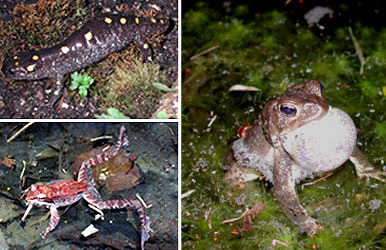Eggs That Scram
BU researchers find amphibian embryos hatch early to evade killer mold

Every spring, there’s a deadly competition in the cold, muddy waters of New England’s forest and woodland pools. Toad, salamander, and frog embryos race to hatch from egg clutches laid along leaves and branches before succumbing to a ubiquitous creeping predator — water mold.
In the spring of 2005, Boston University scientists ventured into the woods of Lynn, Mass., to observe how local amphibian species deal with this perennial threat. They discovered that while some embryos have their parents to thank for their protection, others are basically on their own and can hatch more than 30 percent early to evade the lethal mold. Their findings, published in the October issue of Ecology, have potential implications for habitat conservation as well as for the scientific understanding of the earliest stages of animal life.
The BU research followed recent die-offs of amphibians in the Pacific Northwest resulting, it was suspected, from water mold acting in conjunction with additional environmental stressors such as increased ultraviolet radiation exposure or unusual temperature changes. Despite the plausibility of those theories, says Ivan Gomez-Mestre, a College of Arts and Sciences postdoctoral research associate in biology, “no one had actually tried to figure out what these species’ normal defenses are to water mold.”

So, Gomez-Mestre, along with Karen Warkentin, a CAS assistant professor of biology, and Justin Touchon (GRS’09), a biology doctoral student, selected three common amphibians — spotted salamanders, wood frogs, and American toads — and used brightly colored tape to flag their egg clutches in the Lynn Woods Reservation. Between March and June 2005, they tromped around nine vernal pools in rubber waders and monitored the clutches for mold infection and embryo mortality. They also collected some for laboratory experimentation and observation.
While most of the pools had plenty of mold, the scientists found that each species has its way of coping. Salamanders, for instance, lay up to 100 eggs inside a thick jelly coating that keeps the mold at bay. Wood frog eggs don’t have as much protective jelly, but these embryos benefit from the frogs’ extremely early breeding cycle, giving them a chance to hatch before the water warms and mold thrives. The least amount of jelly protects the American toad egg clutches, which can be bigger than baseballs and contain thousands of embryos. The toads also mate later in the spring, missing the protection of chilly water. Mold was all over these clutches. Nevertheless, three quarters of the embryos survived, often by sensing the mold and hatching between 30 and 40 percent prematurely.
“What’s amazing is that the earliest hatching embryos are so undeveloped that they’re not capable of muscular contraction; they can’t swim away,” explains Gomez-Mestre. Consequently, the toad hatchlings simply drift away from danger with the help of cellular cilia and then proceed to develop normally. In fact, after the toad tadpoles can feed on their own, they occasionally return to the clutch and eat the very mold that chased them from their eggs, a twist Gomez-Mestre jokingly dubs “ecological justice.”
In the lab, the researchers were able to induce early hatching in the egg clutches of other species by removing the protective jelly and inoculating them with mold. These findings build on Warkentin’s earlier discoveries of embryonic responses in tropical tree frogs, which hatch early to avoid predator snakes.
“All of this adds to the picture that embryos respond in adaptive ways to their environment,” says Warkentin. “They’re not just developing to get ready for their future life. They also have characteristics that have been shaped by a history of interactions with life at that early stage.”
Still, while Warkentin has done years of experimentation showing how the tree-frog embryos sense approaching danger via specific vibration patterns, she and the other BU scientists don’t know how embryos sense mold. “It’s definitely not chemical cues,” says Gomez-Mestre, since the embryos hatched early only when in physical contact with mold. “It could be tactile stimulus,” he says, “or it could be, for example, that the mold is using up oxygen in the vicinity and the embryos sense a drop in oxygen.”
In addition to investigating the mechanism of early hatching, the BU scientists also want to look into the effects of environmental stressors, such as rising global temperatures and pesticides and other pollutants, experiments that could inform efforts to protect their habitats.
“All these embryonic defenses are actually a race against the water molds, because there’s a minimum developmental stage they need to reach before they can hatch,” says Gomez-Mestre. Thus, if global warming allows water mold to grow faster or if pesticides delay amphibian embryo development, massive die-offs could result. The research, says Warkentin, reveals “a much richer, more complex picture of the interactions within that ecological community.”
Chris Berdik can be reached at cberdik@bu.edu.